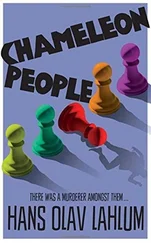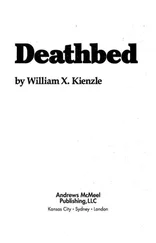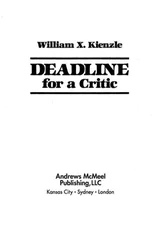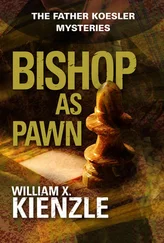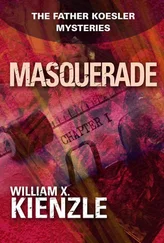William Kienzle - Chameleon
Здесь есть возможность читать онлайн «William Kienzle - Chameleon» весь текст электронной книги совершенно бесплатно (целиком полную версию без сокращений). В некоторых случаях можно слушать аудио, скачать через торрент в формате fb2 и присутствует краткое содержание. Жанр: Криминальный детектив, на английском языке. Описание произведения, (предисловие) а так же отзывы посетителей доступны на портале библиотеки ЛибКат.
- Название:Chameleon
- Автор:
- Жанр:
- Год:неизвестен
- ISBN:нет данных
- Рейтинг книги:5 / 5. Голосов: 1
-
Избранное:Добавить в избранное
- Отзывы:
-
Ваша оценка:
- 100
- 1
- 2
- 3
- 4
- 5
Chameleon: краткое содержание, описание и аннотация
Предлагаем к чтению аннотацию, описание, краткое содержание или предисловие (зависит от того, что написал сам автор книги «Chameleon»). Если вы не нашли необходимую информацию о книге — напишите в комментариях, мы постараемся отыскать её.
Chameleon — читать онлайн бесплатно полную книгу (весь текст) целиком
Ниже представлен текст книги, разбитый по страницам. Система сохранения места последней прочитанной страницы, позволяет с удобством читать онлайн бесплатно книгу «Chameleon», без необходимости каждый раз заново искать на чём Вы остановились. Поставьте закладку, и сможете в любой момент перейти на страницу, на которой закончили чтение.
Интервал:
Закладка:
“Okay…” Tully slapped the desk top, then stood. “Let’s get back on the street. Make sure everybody’s got the word about how the perp’s M.O. has changed. The planning from here on in … if there are any more hits planned-and I feel there will be-from now on he’s liable to be sloppy. Or, if we’re dealing with two or more nuts, the M.O.’s liable to change totally. We’ve got to hope for some kind of a break. Meantime, double up the protection for the nun. And get on the possibility that somebody at the Pontch Wine Cellars might identify either Carson or Stapleton.
“Let’s hit the bricks,”
The three rose and prepared to leave, though Koesler surely was not going to “hit the bricks,”
“Oh,” Tully said in afterthought, “and Father Koesler: If you think of anything, call-doesn’t matter when. Call here, They’ll know where to find me.”
Tully was still banking on Koesler’s coming up with some sort of Churchy insight that might break this puzzle open. In this, Tully was much more optimistic than was the priest himself.
The walk home, from police headquarters to St. Joseph’s, was not a great distance, but it was bitterly cold. Gratiot Avenue was not that far removed from the Detroit River and its icy breezes, and there was that unprotected overpass across the Chrysler Freeway.
As he walked, Father Koesler thought of Clete Bash, and how, earlier this very day, he too had walked a downtown street. He had had no way of knowing he was heading toward his final moment on earth. When it came right down to it, no Detroit priest or nun-or anyone employed by the archdiocese-had any clue as to whether they-any of them-were on this madman’s list.
There were no lights on in the ancient rectory when Koesler let himself in. He went directly to the kitchen. It was the warmest room in the old building. There he found a note from Mary O’Connor telling him his dinner was in the oven and giving specific instructions on how to heat it. He thought the instructions a bit much, but then he remembered a time he had put a frozen dinner including the cardboard box containing it into the oven to heat. Over the years, Mary had come to know him better than he knew himself.
He followed her instructions to the letter.
He felt frozen to the bone. So he mixed himself a Scotch and water. The first sip sent a welcome wave of warmth through his still-shivering body. He glanced at the afternoon paper’s front page. No mention of Father Bash’s murder. It must have happened too late for their deadline. The story surely would be the top headline in both morning and afternoon papers tomorrow.
To be followed by … whom? Sister Joan? Would the killer, now in seeming haste, double back and pick off the one target he seemed to have missed? Would all the present police protection scare him off? Could anything frighten off a person that determined on a plan of destruction?
Sister Joan … something rattling around in his memory.
Sister Joan was the first intended victim … or so the theory went. But her executioner failed, and so he moved on to the second, then the third, then the fourth victims, never returning to the first failed effort.
Hadn’t Koesler been thinking of something similar recently? Something in the liturgy?
Of course; it was the feast of St. John the Apostle and Evangelist.
Koesler dug out his copy of The Oxford Dictionary of Saints. John suffered “(according to ecclesiastical tradition) under Domitian’s persecution, from which, however, he escaped alive and ended his days at an advanced age at Ephesus.”
But legend had it that all the apostles died martyrs. Even though John did not actually die for his faith, the Emperor Domitian did his level best to try to make John a martyr. And despite his escape, the Church considers him a martyr.
Like St. John, Sister Joan escaped her executioner. Somebody who was well instructed in Christianity would be familiar with the St. John legend. And whoever was responsible for this series of murders very likely would fit that profile. So Sister Joan, if Koesler were correct, would no longer be a murder victim candidate. She hadn’t been murdered any more than St. John had. But both had been handed “the palm of martyrdom”- honoris causa , as it were.
His first impulse was to call Lieutenant Tully and inform him of this new line of reasoning. Instead, he paused. He felt that he was on some sort of deductive roll. Now that he had a clear impression of how this still-living nun fit into the picture, he might be on the verge of identifying that elusive thread that tied this string of murders together.
Something … something … something. It was something someone had said. The clue was so close at hand, lurking just on the edge of his mind. He was sure that if he could just relax and let his mind take its own tour in a stream of consciousness, it would surface. He took another sip of his drink. He was relaxing and his mind seemed right on target.
Meanwhile, his dinner was not only badly overdone, it was on the verge of catching fire.
Sure enough, the front pages of both the Detroit News and the Free Press were full of Father Cletus Bash’s murder at midday on Washington Boulevard. That was the lead story and it was amplified both on page one and on the jump pages by sidebars covering the brief history of these serial murders and reports on the progress and lack of same of the police investigation.
Buried somewhere in the midst of these stories was the announcement by Robert Meyer, acting spokesman for the archdiocese of Detroit, to the effect that, immediately following Father Bash’s funeral, Cardinal Boyle would leave on a combined spiritual retreat and vacation. The Cardinal’s doctor was quoted as saying there was no emergency, but that the prelate was in need of some rest and solitude. Recent events and the tragic attacks on Church leaders had taken their toll. As his doctor put it, the archbishop needed to recharge his batteries.
No specific destination or duration was mentioned, only that he would be sojourning in a warmer clime for as long as it took to get those batteries recharged.
29
Cardinal Mark Boyle lived in what was by just about anyone’s standards a mansion. It was located in Palmer Woods, a square mile enclave just inside Detroit’s northern limits. Mansions are plentiful in this luxurious section, but the former residence of Bishop Michael Gallagher and Cardinal Edward Mooney and present residence of Cardinal Boyle well overshadowed its surrounding homes.
Traditionally, the neighborhood is quiet, elegant. But with the market value of these homes, one could expect little else.
It was quiet on this beautiful winter evening. Clear skies, lots of stars; only a quarter moon that shed little light. The drowsy dark was pierced only occasionally by a streetlight.
The streets were empty, except for the occasional car that would creep over the slippery pavement and turn in at a driveway to be tucked into its garage for the night.
One such vehicle, a late model black four-door Taurus, inched along the street, but did not turn in at any driveway. Instead, it circled the neighborhood as if the driver were on a sightseeing tour of the mansions. It drew no attention; one would have to have been watching the streets for some time and with concentration to note that the same car had passed not once but several times. And no one was paying that sort of attention.
Finally, the Taurus pulled to a stop on Balmoral. The driver got out of the car and opened the rear door. Out popped a Heinz 57 mutt with a stubby, furiously wagging tail; The man attached a lead to the pup’s collar, which was devoid of any identifying tags or license.
He set off at a normal pace, pausing only when the dog investigated a tree or a fire hydrant. To anyone who might have paid him any mind in the dim light, he was a neighborhood resident, home from a day of wheeling and dealing, walking his dog after dinner. The dog was a perfect pretext for strolling through the neighborhood.
Читать дальшеИнтервал:
Закладка:
Похожие книги на «Chameleon»
Представляем Вашему вниманию похожие книги на «Chameleon» списком для выбора. Мы отобрали схожую по названию и смыслу литературу в надежде предоставить читателям больше вариантов отыскать новые, интересные, ещё непрочитанные произведения.
Обсуждение, отзывы о книге «Chameleon» и просто собственные мнения читателей. Оставьте ваши комментарии, напишите, что Вы думаете о произведении, его смысле или главных героях. Укажите что конкретно понравилось, а что нет, и почему Вы так считаете.

